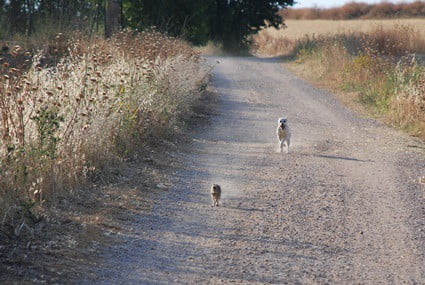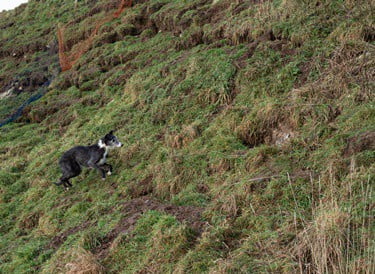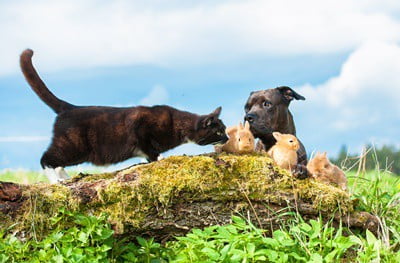Dogs aren’t always viewed as natural hunters. They’re loyal, friendly, and make wonderful companions. But like all animals, canines have a strong predator instinct that stems from their days as a wild animal. As small, vulnerable animals, baby rabbits are easy to catch and kill and often find themselves as a canine’s main catch.
Many dog breeds were once working dogs used for hunting bunnies to keep rabbit populations under control. This means dogs have retained their predatory instincts from their hunting days. While it’s uncommon for dogs to eat bunnies, doing so is part of the natural life cycle. Dogs also love to chase rabbits for fun as it enables them to release pent up energy. To prevent this, you’ll need to train your dog as a puppy to ignore bunnies or distract them by using treats and commands.
When a dog attacks a rabbit, it’s unpleasant for everyone. It’s distressing for you as the dog owner and mother rabbit rarely gets over the shock. With time and training, it’s possible to stop a dog from attacking a bunny.
Why Do Dogs Kill Baby Rabbits?
Not all dogs have the urge to kill bunnies, but many dog breeds have a strong hunting instinct. A canine’s hunting behavior stems from its time in the wild when dogs needed to hunt and catch their prey to survive. Small mammals, like mice and baby rabbits, which are slower and more vulnerable than larger rabbits, are easy for dogs to kill and eat.
Even though the US National Library of Medicine suggests that dogs were likely the first pet to become domesticated, humans would historically use dogs to sniff out rabbits and displace them from their burrows to control the pest population.
Rabbit hunting is difficult without canine help. They’re small, fast, and hard to catch. Rabbits also live in burrows that go deep into the ground. Humans can’t reach them, but small dogs can – which is why terriers and other small breeds have always been preferred for rabbit hunting.
While pet dogs are now less likely to hunt baby rabbits for food, some dog owners encourage them to pursue bunnies for sport, which means some breeds have retained their hunting instincts. Farmers still use certain dog breeds, like Terriers, Lurchers, and Pointers, for pest control to protect their crops.
If your dog kills a baby rabbit, it’s because its hunting instinct is strong and it’s merely giving in to its natural behavior. While unpleasant and relatively uncommon in pets, it’s quite normal for dogs to eat baby rabbits.
Why Do Dogs Like to Chase Bunnies?
Bunny chasing is motivated by a strong prey drive. Many dog breeds were bred to chase bunnies and other animals that move. A prey animal’s instinctual response is to run, and dogs can’t resist but to give chase.
Chasing is also fun for dogs. It stimulates them both mentally and physically and allows them to release pent up energy. When your dog is in the middle of a chase, it will ignore any calls to stop it because it is so focused on catching its prey.
As small, fast animals, most bunnies can escape a dog’s clutches. But not all dogs will kill the bunny it manages to catch. Some will sniff the animal or encourage it to play. Many dogs will let the rabbit run away because it doesn’t know what to do with it.
However, once a dog has chased a bunny, it is likely to repeat this behavior unless it is encouraged to stop. It may also progress to killing and eating the bunny as it gains more confidence.

How to Prevent Dogs from Eating Baby Rabbits?
While it’s uncommon for dogs to eat baby rabbits, it is part of the natural life cycle. However, as a dog owner, you’ll likely want to prevent this kind of behavior altogether. Not only is it unpleasant for you, but it’s traumatic for the baby rabbit and its mother.
According to the Oregon State University, dogs bred for predatory traits are better at following some human gestures. This means they’re easier to train. Try these three methods to stop your dog from eating baby rabbits:
Desensitize
With some dogs, teaching them to ignore the bunny is the most effective training method. The aim is to encourage your dog to ignore the toy so that it will ignore bunnies in real life, too. It’s simple to do following these straightforward steps:
- Find a toy that looks like a rabbit and put it in the same room as the dog.
- Keep your pet away from the toy and put a leash on your pet for safety.
- If your dog ignores the toy, reward it with a tasty treat.
- Take a step closer towards the toy, paying close attention to your dog’s body language. Distract your dog and offer another reward.
- Keep repeating the steps above, trying out new spots until your dog learns to leave the rabbit altogether.
With the desensitize method, positive reinforcement using your pet’s favorite treats is essential to achieve the best results.
Prevent Chasing
For dogs, the chase is the most thrilling aspect of the rabbit hunt. By denying a dog the chance to chase, you’re removing the reward. In turn, this should stop your dog from attacking and eating baby rabbits altogether.
Whenever you go on a walk, especially where baby rabbits burrow, keep your dog on a leash. Then, try these steps:
- If your dog doesn’t already know it, teach your dog to understand “sit” using positive reinforcement.
- Shout “sit” and allow your dog to sniff a treat you have in your hand.
- While your dog is sniffing your hand, raise it above its head. Your dog will follow the treat and automatically park its bum on the floor.
- Command your dog to “sit” and offer it the treat.
- Keep practicing this until your dog understands that the command relates to the sitting action.
- Leave longer gaps in between each command before you reward your dog.
- Eventually, start taking the treat away so that when you see a bunny or rabbit, your dog will understand not to chase.
This is an effective method for obedient dogs who become over-excited when seeing small prey animals.
Distraction
If your dog has an obsession with chasing bunnies and rabbits, distracting it might be the only way. If so, follow these steps:
- Remove your dog’s attention from the rabbit by holding a treat near its nose. Slowly move the treat up towards your eyes for your dog’s gaze to follow.
- Hold the treat and firmly tell your dog to “look.” Repeat the command if your dog looks away.
- Once your dog has successfully held your gaze for around 10 seconds, give it the treat.
- Keep repeating the above steps, holding the treat for longer each time.
- Eventually, stop giving your dog the treat – it will now understand the “look” command.
The next time you see a bunny, distract your dog by shouting the command and hold its gaze until the rabbit has hopped away to safety.
How to Protect a Bunny Nest from Dogs
A bunny nest is a shallow, bowl-like dome in the ground lined with dry grass, leaves, and rabbit fur. It’s where a rabbit keeps her bunnies safe. To do so, she covers the nest with more dried grass and fur to camouflage the babies from danger.
Bunny rabbits have no scent, so a mother rabbit will leave her young in the nest to protect them, coming back a few times a day between dusk and dawn to feed them. Bunnies only stay in the nest for around three weeks – after which they begin to leave the nest and explore their surroundings.
Rabbits sometimes choose yards with dogs as predators like birds and raccoons are more likely to avoid them. However, if a dog spots a bunny nest in the yard, it may become preoccupied with the bunnies inside – especially as there is no noticeable scent from the babies.
To prevent your dog from disturbing the nest and the bunnies hiding inside it, keep it on a leash for three weeks while the bunnies take refuge. Once they have left the nest, your dog will be able to roam the yard freely once again.
It might also be worth cordoning off the nest with some sort of fencing that stops your dog from getting close to the nest. If you decide to take this approach, make sure there’s a gap small enough for the mother rabbit to get through.
Dogs Breeds Most Likely to Attack Baby Rabbits
Not all dog breeds are interested in baby rabbits. Many choose not to give chase and will ignore both pet and wild rabbits altogether.
However, dog breeds with a history of rabbit hunting are more likely to retain these instincts and attack baby rabbits if given a chance. The most common breeds to do so are as follows:
Cairn Terrier
Originating from Scotland, the Cairn is the oldest working terrier and was initially bred to hunt rabbits and other vermin animals to control their populations. Over time, the breed became useful during hunting sports because of their boundless energy and relentless temperament – Cairns won’t give up the chase until they have caught the rabbit, even if they are injured.
If untrained or left unattended for long periods, a Cairn’s hunting instincts will kick in, resulting in destruction around the home. If a Cairn spots a rabbit while on a walk, it will often give chase if not held back by a leash.
To kill a rabbit, a Cairn will grab the rabbit by the neck and rag its body until the neck breaks. A Cairn will often practice this move on its toys, so it’s wise to exercise caution whenever you’re walking where rabbits are present.
Lurcher
The Lurcher is a mixed-breed hound that is a cross between a Sighthound, like a Greyhound or Whippet, and another working dog, like a terrier. Because of this hybridization, Lurchers are highly intelligent, super-fast animals, making them the ideal breed to root out and chase bunnies. Many farmers and gamekeepers use them to control the rabbit population.
As Lurchers have such strong hunting instincts, they’re not the best pet to have alongside bunny rabbits. However, if you introduce both animals from an early age, there’s a chance you could train these instincts out of your Lurcher, allowing both dog and bunny to live in harmony.
Beagle
The Beagle is a scent hound that was bred to hunt bunnies, small rabbits, and hares. Like many other working dogs, they have strong hunting instincts, which hark back to the 1800s when Beagles were taught to hunt.
Beagles possess a strong sense of smell, high energy levels, and a strong will to catch up to their prey. As a starting point, Beagles and bunnies aren’t the most compatible animals.
Beagles tend to harass pet rabbits and need wide spaces to run, so they can’t be left alone with outdoor rabbits. Any sudden movements a baby bunny makes will be seen as a threat and could lead to a fight.
Not only would this lead to injury, but your bunny will live its life in a state of stress – which can lead to an early death. Keeping the two animals apart at all times is advised. If this is unachievable, owning both a Beagle and a bunny may not be possible.

Siberian Husky
Siberian Huskies are large dogs with a high prey drive. Young pups present no apparent threat to bunnies and other small animals, lulling owners into a false sense of security that they are safe to be around bunnies.
However, Huskies develop their predatory instincts when they mature after a few years. At this point, the breed will become a problem for pet bunny rabbits.
While Siberian Huskies are rarely aggressive, they’re powerful dogs and can cause serious injury to small, fragile bunnies. Also, as large, intimidating dogs, bunnies will become stressed out by the dog’s presence, leading to a range of behavioral and health issues.
Training can suppress a Husky’s desire to hunt rabbits, but it’s best to separate both animals at all times. Similarly, Huskies should never be in the presence of house rabbits because it’s too difficult to keep them apart. Once a Husky’s prey instinct kicks in, it’s too hard for the dog to ignore.
Miniature Dachshund
Don’t be fooled by the Miniature Dachshund’s small size – they are natural-born hunting dogs with a successful history of sniffing out hiding rabbits. They’re also very quick on their feet and can easily keep up with speedy bunnies attempting to make a quick getaway.
When it comes to the safety of wild bunnies, Dachshunds are expert diggers and will dig through a rabbit’s burrow to reach vulnerable bunnies. If your dog is not kept on a leash during a walk, it may head off in search of rabbits.
Because of these strong hunting instincts, your dog needs to be supervised around bunny rabbits at all times. Dachshunds are challenging to train, so it’s too risky to trust your dog around your bunny.
Some dogs will always possess the hunting instinct and can never be trained to leave baby bunnies alone. This is stressful for both the dog, who will stop at nothing to get to the bunny, and the baby rabbit, who wants to be left alone.
To protect wild bunnies, you must keep your dog on a leash in areas where bunnies are present. And for pet rabbits, do your research beforehand to see if your chosen dog breed is compatible with living alongside a baby bunny. If you don’t, life could become stressful for all animals.

